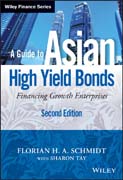
An up–to–date, comprehensive analysis of the high–yield bond market in Asia Beginning with a general definition of high–yield bond products and where they reside within the corporate capital structure, this newly updated guide looks at the development of high–yield bonds in the United States and Europe before analysing this sector in Asia. It covers issuer countries and industries, ratings, and size distributions, and also covers the diversification of the high–yield issuer universe. It includes a thorough technical analysis of high–yield bond structures commonly employed in Asian transactions, including discussion of the respective covenants and security packages that vary widely across the region. Chapters and sections new to this edition cover such subjects as high–yield bond restructuring, the new high–yield Dim Sum market, and the high–yield placement market shutdown of 2008 – 2009. Finally, the book looks at the new characteristics of Asian economies for indicators on how the high–yield market will develop there are the near future. Offers an extremely detailed analysis of Asia?s high–yield bond market Features new and updated material, including new coverage of the key differences between Asian structures and United States structures Ideal for CFOs of companies contemplating high–yield issuance, as well as investment bankers, bank credit analysts, portfolio managers, and institutional investors INDICE: Preface xi Acknowledgments xvii CHAPTER 1 Why High Yield’s Time Has Come in Asia 1 1.1. The Asia Pulp & Paper (APP) Legacy 1 1.2. Necessary Corporate Developments Benefiting Asian High Yield 4 1.3. Necessary Macro Developments Benefiting Asian High Yield 8 1.4. Asia’s Corporate Landscape of Family Enterprises 12 1.5. Traditional Generic Business Strategies for Family Enterprises 12 1.6. A Theoretical Approach to Debt versus Equity Funding 15 1.7. The Factor “Growth” Makes All the Difference 17 1.8. An Asian Growth Market: China’s Real Estate Sector 19 1.9. Suitability of High Yield Bonds for Family Enterprises 21 1.10. A Wall of Liquidity 27 Notes 31 CHAPTER 2 An Overview of the High Yield Bond Market 33 2.1. The Genesis 33 2.2. The World’s Largest High Yield Bond Market 36 2.3. Europe’s Growing High Yield Bond Market 42 2.4. “True” High Yield Arrives in Asia 50 2.5. The Asian High Yield Renaissance 57 2.6. Through and Beyond the Subprime Crisis 71 2.7. The Asian High Yield Market Comes of Age 80 2.8. More Tests of Resilience 84 2.9. Outlook—Disintermediation of Bank Lending 97 Notes 98 CHAPTER 3 Asian High Yield Issuers 101 3.1. What’s in a Name? 101 3.2. The Technology, Media, and Telecoms Sector 102 3.3. The PRC Real Estate Sector 119 3.4. The Metals and Mining Sector 151 3.5. Highly Concentrated New Issue Universe 190 3.6. Issuer Interviews 192 3.7. Australian Corporates Enter the High Yield Market 201 Notes 208 CHAPTER 4 The Buy–Side and Secondary Market for Asian High Yield 211 4.1. The Age of Liquidity 211 4.2. The New Fast Money Reality in Asia 216 4.3. “Real Money” Institutional Investors 218 4.4. The Regional Private Wealth Management Bid 224 4.5. Regulation S versus 144A 227 4.6. Why Going Down the Credit Curve? 235 4.7. Investors’ Approach toward High Yield 241 4.8. Limitations of Acceptance 250 4.9. Trading Asian High Yield 252 4.10. Investors in the Future, for the Future 259 Notes 275 CHAPTER 5 Structuring and Transacting High Yield Bonds 277 5.1. Changes in the Corporate Capital Structure 277 5.2. Structuring High Yield Bonds 282 5.3. Disclosure for High Yield Bonds 300 5.4. Marketing, Pricing, and Distributing High Yield Bonds 308 5.5. Credit Ratings and the Ratings Advisory Process 325 Notes 339 CHAPTER 6 Asian High Yield Bond Covenants Offer Superior Investor Protection 341 Jeannie–Marie Noyce, Alexander Dill, and Laura Acres 6.1. Key Concepts in Assessing Covenant Structures 343 6.2. Structural Protections against Key Risks Follow a Common Pattern Globally 348 6.3. The Standard Asian High Yield Structure 349 Note 363 CHAPTER 7 High Yield Bonds in Distress—Workout and Recovery 367 7.1. Corporate Governance Issues in China 367 7.2. The Asia Aluminum Case 369 7.3. Lessons from the Asia Aluminum Case 373 7.4. Capital Structure and the Lender—Noteholder Relationship 376 7.5. The Meaning of Structural Subordination 378 7.6. Distressed Exchange for Titan Petrochemicals 381 7.7. The Red Dragon/Central Proteinaprima Case 383 7.8. The Davomas Case 388 7.9. Default Rates in Asia’s High Yield Space Remain Low 391 7.10. Conclusion 393 Notes 396 CHAPTER 8 The Rise and Fall of the Asian High Yield Private Placement Market 399 8.1. Key Market Characteristics 399 8.2. Private Placement Structures 401 8.3. Supply Side Attractions 402 8.4. The Private Placement Issuance Process 407 8.5. Investors’ Motivations 409 8.6. The Collapse of Asia’s High Yield Private Placement Market 412 8.7. The Missing Piece in Asia’s Credit Culture? 413 Notes 414 CHAPTER 9 High Yield Funding in Renminbi 415 9.1. An Asian Currency Corporate Bond Market—At Last? 415 9.2. The Anatomy of the CNH Market 416 9.3. What Are the Benefits of Dim Sum Bonds? 418 9.4. Cumbersome Repatriation Process 422 9.5. Synthetic Renminbi Bonds 426 Notes 427 About the Author and Contributor 429 About the Website 431 Index 433
- ISBN: 978-1-118-50202-0
- Editorial: John Wiley & Sons
- Encuadernacion: Cartoné
- Páginas: 480
- Fecha Publicación: 28/11/2013
- Nº Volúmenes: 1
- Idioma: Inglés
